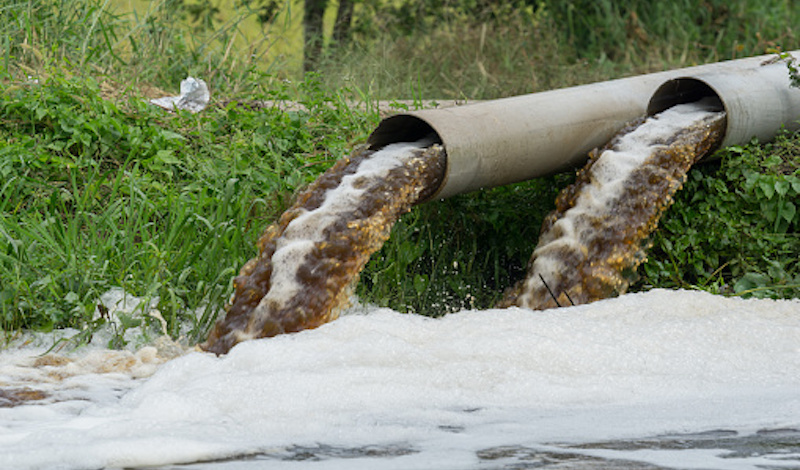
Courts disagree over the Clean Water Act’s applicability to the discharge of pollutants into groundwater.
In a recent dissenting opinion, Judge Eric Clay began with a question that summed up a key issue in the case: “Can a polluter escape liability under the [Clean Water Act] by moving its drainage pipes a few feet from the riverbank?”
A majority for the U.S. Court of Appeals for the Sixth Circuit answered this question with a “yes,” and in doing so diverged from the answer two other federal courts gave earlier this year.
In two cases decided by the Sixth Circuit on the same day, environmental groups alleged that coal-fired utility plants violated the Clean Water Act by releasing coal ash into the fresh water held underground by rocks and soil—known as groundwater—without a permit. The Sixth Circuit held in each instance that the Act does not require permits for the discharge of pollutants into groundwater that subsequently flows into navigable waters, which include all the lakes, rivers, streams, wetlands, and areas of the ocean within the territory of the United States.
Of critical importance to the genesis of this circuit split are differing interpretations of the phrase “to navigable waters” and its relation to point sources—the specific, identifiable places that release pollution. This difference likely creates a question of law ripe for review by the U.S. Supreme Court.
Central to all of these recent decisions is a debate over statutory interpretation—that is, how should courts interpret the language of the Clean Water Act? Designed to “restore and maintain the chemical, physical, and biological integrity of the Nation’s waters,” the Act’s broad-sweeping language prohibits the “discharge of any pollutant” without a permit. According to the definitions provided by the Act, discharge of a pollutant means “any addition of any pollutant to navigable waters from any point source.” The Act also defines “navigable waters” as “the waters of the United States, including the territorial seas” and “point source” as a “discernable, confined, and discrete conveyance.”
These broadly defined terms have proven to be anything but straightforward. In fact, environmental groups, government agencies, and other private parties have been involved in litigation contesting the meanings of these terms since Congress passed the Act in 1972.
The environmental groups in the cases recently decided by the Sixth Circuit, presented two theories explaining why the groundwater discharges required permits. The first theory is that groundwater can be considered a point source within the definition provided by the Act. Arguing in the alternative, the second theory is that the coal ash ponds themselves qualify as point sources. The argument follows that when coal ash leaches into groundwater, that groundwater acts as a medium that then transports those pollutants into navigable waters. This second theory is better known as the “hydrological connection” or “conduit” theory.
Judge Richard Suhrheinrich—rejecting both theories on behalf of the majority—explained that in other sections, the authors of the Clean Water Act used the phrase “into navigable waters.” Thus, relying on both textual and contextual analysis, Judge Suhrheinrich reasons that “for a point source to discharge into navigable waters, it must dump directly into those navigable waters—the phrase “into” leaves no room for intermediary mediums to carry the pollutants.”
The environmental groups, however, pointed to the fact that the Act’s definition of “discharge” says “to navigable waters,” not “into.” Further, in Rapanos v. United States, the Supreme Court clarified that “the Act does not forbid the ‘addition of any pollutant directly to navigable waters from any point source,’ but rather the ‘addition of any pollutant to navigable waters.’” This interpretation is used to argue that it does not matter whether pollutants are directly added to navigable waters, just that they end up there.
At least two other courts have adopted versions of this argument. In a similar factual situation where pollutants discharged into groundwater made their way to the Pacific Ocean, the U.S. Court of Appeals for the Ninth Circuit, in Hawaii Wildlife Fund v. County of Maui, held that the polluter was liable under the Clean Water Act because the pollutants were “fairly traceable from the point source to a navigable water such that the discharge is the functional equivalent of a discharge into the navigable water.”
Similarly, the U.S. Court of Appeals for the Fourth Circuit explained in Upstate Forever v. Kinder Morgan Energy Partners that “a point source is the starting point or cause of a discharge under the [Clean Water Act], but that starting point need not also convey the discharge directly to navigable waters.”
The Sixth Circuit, however, did not agree with these interpretations. “Had it wished to do so, Congress could have prohibited all unpermitted discharges of all pollutants to all waters. But it did not go so far,” Judge Suhrheinrich wrote, adding that Congress did not intend to “pursue its stated goal at all costs.”
Although Judge Suhrheinrich and the majority relied heavily on a textual interpretation of the Clean Water Act, in his dissent Judge Clay emphasized the purpose of the Act. In his view, the majority’s argument creates “a gaping regulatory loophole,” inconsistent with both the text and purpose of the Act. Under the majority’s approach, “polluters can avoid Clean Water Act liability by discharging their pollutants into groundwater, even if that groundwater flows immediately into a nearby navigable water,” he said.
The federal courts have not been the only ones to weigh in on the debate over the interpretation of the Clean Water Act recently. In fact, the Sixth Circuit’s decisions came on the heels of the Trump Administration’s decision earlier this year to formally suspend the Waters of the United States rule—an Obama Administration rule clarifying the scope of the Act—until 2020. In a court challenge brought by the Southern Environmental Law Center, however, a federal judge struck down the suspension, holding that EPA did not allow a meaningful public comment period. Most recently, EPA announced a notice of proposed rulemaking for a new definition of the “waters of the United States” to replace the Obama-era definition.
The new rulemaking and lingering confusion over how courts should interpret the Clean Water Act created by the Sixth Circuit’s decision means that industry, environmental groups, and EPA may end up turning to the Supreme Court for clarification.
The two cases decided by the Sixth Circuit were Ky. Waterways Alliance v. Kentucky Util. Co. and Tenn. Clean Water Network, et al. v. TVA.



